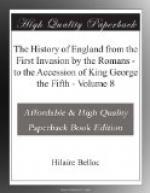[Sidenote a: A.D. 1645. Jan. 22.]
away; part after part was detached from the edifice; and the reformers hastened to raise what they deemed a more scriptural fabric on the ruins. In the month of June, 1643, one hundred and twenty individuals selected by the Lords and Commons, under the denomination of pious, godly, and judicious divines, were summoned to meet at Westminster; and, that their union might bear a more correct resemblance to the assembly of the Scottish kirk, thirty laymen, ten lords, and twenty commoners were voted additional members. The two houses prescribed the form of the meetings, and the subject of the debates: they enjoined an oath to be taken on admission, and the obligation of secrecy till each question should be determined; and they ordained that every decision should be laid before themselves, and considered of no force until it had been confirmed by their approbation.[1] Of the divines summoned, a portion was composed of Episcopalians; and these, through motives of conscience or loyalty, refused to attend: the majority consisted of Puritan ministers, anxious to establish the Calvinistic discipline and doctrine of the foreign reformed churches; and to these was opposed a small but formidable band of Independent clergymen, who, under the persecution of Archbishop Laud, had formed congregations in Holland, but had taken the present opportunity to return from exile, and preach the gospel in their native country. The point at issue between these two parties was one of the first importance, involving in its result the great question of liberty of conscience. The Presbyterians sought to introduce a
[Footnote 1: Journals, vi. 114, 254. Commons, 1643, May 13, June 16, July 6, Sept. 14. Rush. v. 337, 339.]
gradation of spiritual authorities in presbyteries, classes, synods, and assemblies, giving to these several judicatories the power of the keys, that is, of censuring, suspending, depriving, and excommunicating delinquents. They maintained that such a power was essential to the church; that to deny it was to rend into fragments the seamless coat of Christ, to encourage disunion and schism, and to open the door to every species of theological war. On the other hand, their adversaries contended that all congregations of worshippers were co-ordinate and independent; that synods might advise, but could not command; that multiplicity of sects must necessarily result from the variableness of the human judgment, and the obligation of worshipping God according to the dictates of conscience; and that religious toleration was the birthright of every human being, whatever were his speculative creed or the form of worship which he preferred.[1]




